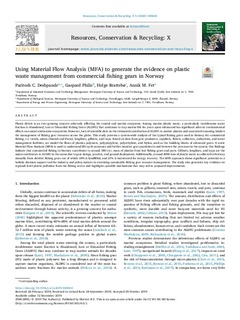| dc.description.abstract | Plastic debris is an ever-growing concern adversely affecting the coastal and marine ecosystem. Among marine plastic waste, a particularly troublesome waste fraction is Abandoned, Lost or Discarded Fishing Gears (ALDFG) that continues to trap marine life for years upon releaseand has significant adverse environmental effects on coastal and marine ecosystems. However, lack of scientific data on the estimated contribution of ALDFG to marine plastics and associated reasoning hinders the management of fishing gear resources across the globe. This study presents a system-wide analysis of the typical fishing gears used in Norway for commercial fishing, i.e. trawls, seines (Danish and Purse), longlines, gillnets, and traps. Based on data from gear producers, suppliers, fishers, collectors, authorities, and waste management facilities, we model the flows of plastics polymers, polypropylene, polyethylene, and Nylon, used as the building blocks of advanced gears. A static Material Flow Analysis (MFA) is used to understand life cycle processes and further monitor gear quantities in and between the processes in the system. Our findings indicate that commercial fishing in Norway contributes to around 380 t/yr. mass of plastics from lost fishing gears and parts. Gillnets, longlines, and traps are the main contributors to ALDFG in the ocean due to gear design, practice, and ground deployment. Additionally, around 4000 tons of plastic waste is collected in Norway annually from derelict fishing gears out of which 24% is landfilled, and 21% is incinerated for energy recovery. The MFA approach shows significant potential as a holistic decision support tool for industry and policy-makers in exercising sustainable fishing gear resource management. The study also generates key evidence on regional level plastic pollution from the fishing sector and highlights possible mechanisms that may aid in proposed improvements. | nb_NO |

